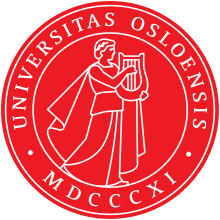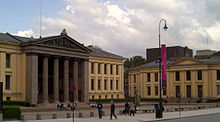
Back جامعة أوسلو Arabic جامعة اوسلو ARZ Oslo Universiteti Azerbaijani اسلو بیلیمیوردو AZB Універсітэт Осла Byelorussian Унівэрсытэт Осьлё BE-X-OLD Университет на Осло Bulgarian Universitat d'Oslo Catalan Univerzita v Oslu Czech Universitetet i Oslo Danish
Universitetet i Oslo | |
 | |
| Latin: Universitas Osloensis[1] | |
Former name | Royal Frederick University (1811–1939) |
|---|---|
| Type | Public research university |
| Established | 2 September 1811[2] |
Academic affiliation | EUA, Guild of European Research-Intensive Universities, UNICA |
| Rector | Svein Stølen |
Academic staff | 7,000 (2020) |
Administrative staff | 1,725 (2020) |
| Students | 28,000 (2020) |
| Location | , |
| Colors | [3] |
| Website | uio.no |

The University of Oslo (Norwegian: Universitetet i Oslo; Latin: Universitas Osloensis) is a public research university located in Oslo, Norway. It is the oldest university in Norway and consistently considered the country's leading university, one of the highest ranked universities in the Nordic countries and one of world's hundred highest ranked universities.[4] Originally named the Royal Frederick University, the university was established in 1811 as the de facto Norwegian continuation of Denmark-Norway's common university, the University of Copenhagen, with which it shares many traditions. It was named for King Frederick VI of Denmark and Norway, and received its current name in 1939. The university was commonly nicknamed "The Royal Frederick's" (Det Kgl. Frederiks) before the name change, and informally also referred to simply as Universitetet (lit. 'the university').
The university was the only university in Norway until the University of Bergen was founded in 1946. It has approximately 27,700 students and employs around 6,000 people.[5] Its faculties include (Lutheran) theology (with the Lutheran Church of Norway having been Norway's state church since 1536), law, medicine, humanities, mathematics, natural sciences, social sciences, dentistry, and education. The university's original neoclassical campus is located in the centre of Oslo; it is currently occupied by the Faculty of Law. Most of the university's other faculties are located at the newer Blindern campus in the suburban West End. The Faculty of Medicine is split between several university hospitals in the Oslo area. The university also includes some formally independent, affiliated institutes such as the Centre for International Climate and Environmental Research (CICERO), NKVTS and the Frisch Centre.
The Nobel Peace Prize was awarded in the university's Atrium, from 1947 to 1989 and in 2020.[6] Since 2003, the Abel Prize is awarded in the Atrium. Five researchers affiliated with the university have been Nobel laureates[7] and three have been Turing Award winners.
- ^ "Search". Internet Archive.
- ^ "University of Oslo (UiO) - Maritime & North Sea Energy Law Education". EduMaritime.net. 25 November 2017. Retrieved 24 October 2018.
- ^ "Fargepalett". University of Oslo. Retrieved 2 February 2022.
- ^ "Inne på topp 100 i rangering av 21.000 universiteter". Khrono. Retrieved 21 May 2024.
- ^ "About Oslo". European Union – Health Education and Management (EU–HEM). Archived from the original on 9 June 2015. Retrieved 16 September 2018.
- ^ "I år skal Nobels fredspris utdeles på UiO - Uniforum". www.uniforum.uio.no (in Norwegian). Retrieved 19 September 2022.
- ^ Nobel Prize Laureates University of Oslo. Retrieved July 22, 2016